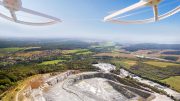Commercial production of undersea mining could become a reality in less than five years, but at a potentially high cost to seafloor ecosystems, panellists told the Prospectors & Developers Association of Canada conference.
Driving the momentum for seafloor mining is a nervousness among United States government officials that China could dominate undersea mining like it has dominated critical minerals, Craig Shesky, chief financial officer of undersea explorer The Metals Company (Nasdaq: TMC), said on Monday.
“I think you’re going to see pre-cash flow positivity, you’re going to see an investable industry,” Shesky said. “I think this feels like offshore oil and gas in the early 1960s and people don’t realize yet that it’s already happening. It’s going to become a very material part of the market, because the technology is there, the resource is there, and now the political appetite is there.”
Vancouver-based TMC is exploring at the Nori Clarion-Clipperton Zone (CCZ) polymetallic project, located 4,000 metres deep in the northeastern Pacific Ocean, between Hawaii and Mexico. The area hosts 345 million measured and indicated wet tonnes grading 1.4% nickel, 1.14% copper, 0.14% cobalt and 31.2% manganese, according to a technical report from 2021. Inferred resources total 11 million wet tonnes at 1.38% nickel, 1.14% copper, 0.12% cobalt and 31% manganese.
Feasibility study
TMC is now conducting an 18-month feasibility program aimed at processing a 2,000-tonne sample of deep-seafloor polymetallic nodules at its partner PAMCO’s Rotary Kiln Electric-Arc Furnace operating facility in northern Japan.
Projects like TMC’s are likely to face greater demand in the coming years as the green energy transition prompts countries to seek more sources of critical minerals needed for zero-emissions technologies.
Mining nickel from the seafloor nodules carries fewer environmental costs than conventional land-based mines, Shesky emphasized.
Asked by fellow panellist and senior ocean scientist Matthias Haeckel “what is the acceptable cost of deepsea mining?”, Shesky responded: “Relative to what?”
“When we’re talking about biodiversity, one estimates in the CCZ we’re talking about a species count nearing 10,000 unique species,” he said. “Let’s put that in perspective to the island of Sulawesi (in Indonesia), where a majority of nickel exploration is ongoing, where 300,000 unique species (live).”
TMC’s planned approach to nodule mining is to start small with one vessel, guided by large amounts of data on environmental impacts, Shesky said.
Eco-system threat
While it might appear that land mining’s cost is larger than undersea mining, it still has a high environmental impact, according to Haeckel, who works for the GEOMAR Helmholtz Institute of Ocean Research in Kiel, Germany.
Haeckel’s research conducted over the last 10 years in the CCZ has revealed that not only is there diversity of coral-like fauna on the seafloor, but some fauna are specifically adapted to living on the polymetallic nodules.
“This fauna actually needs the nodules as a hard substrate to live on. (This) sponge sits rooted on a deepsea polymetallic nodule,” he said, gesturing to a photo on a slide.
Mining the nodules would permanently destroy the creatures’ ecosystem. Even if only five centimetres were removed from the sea floor, thousands of years would be required to redeposit nutrient supply for seafloor life.
“This ecosystem is lost forever for polymetallic nodules,” Haeckel said. “We are talking about 200 to 300 square kilometers being mined per year and operations to get two to three-million tonnes of nodules that the industry typically says (is what) they would need for economic purposes.”






Be the first to comment on "PDAC: Seafloor mining balances pros and cons"